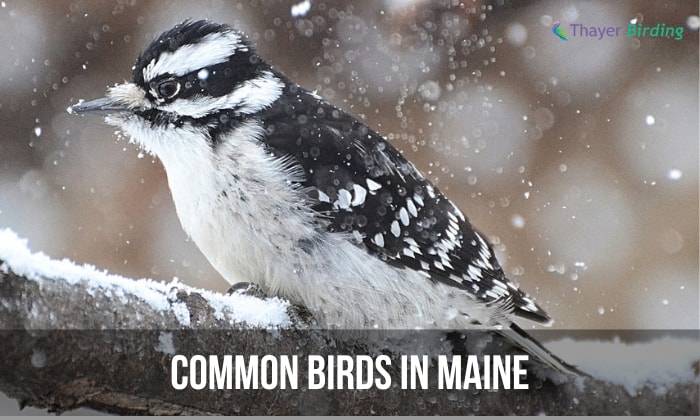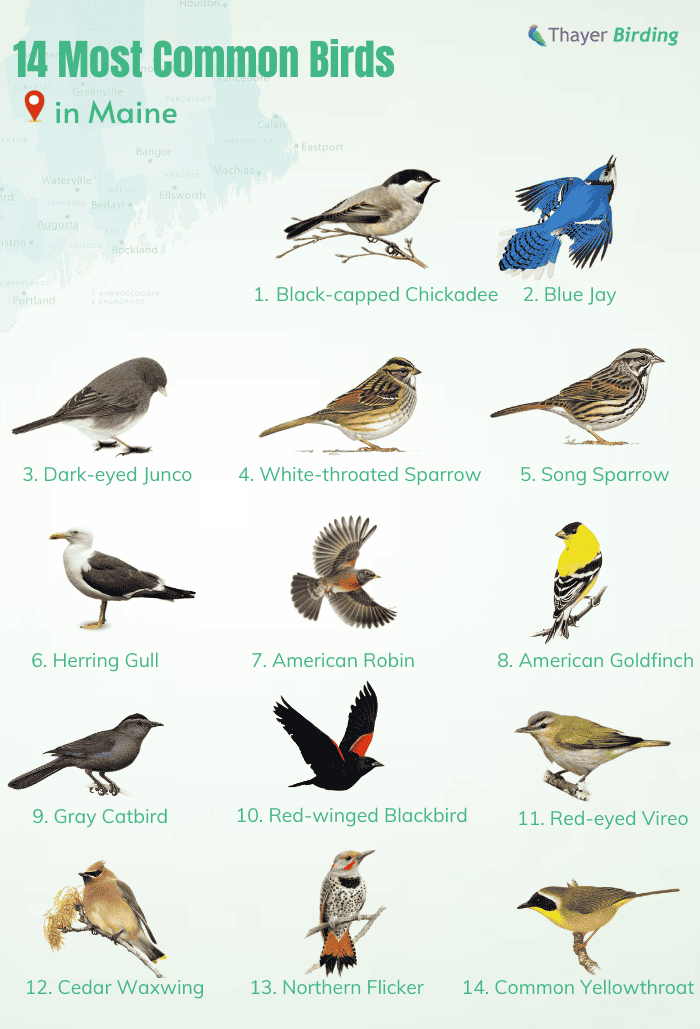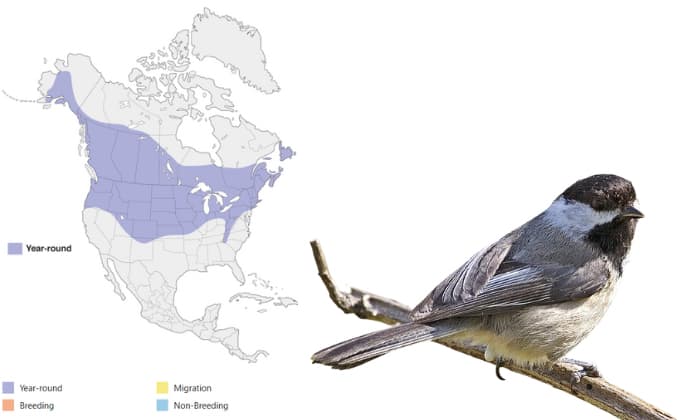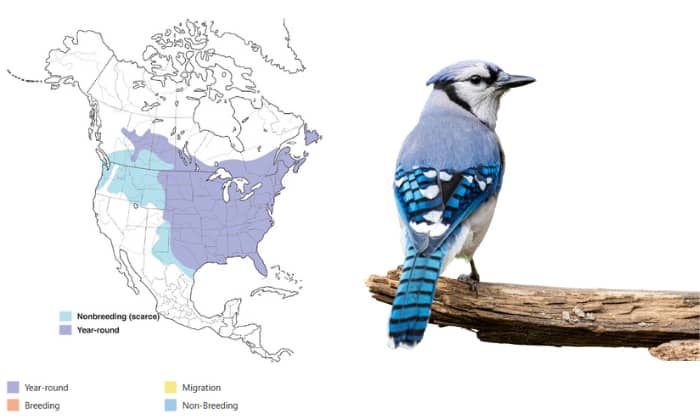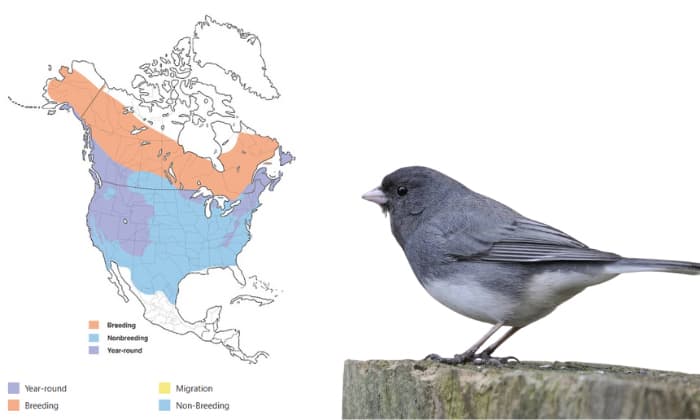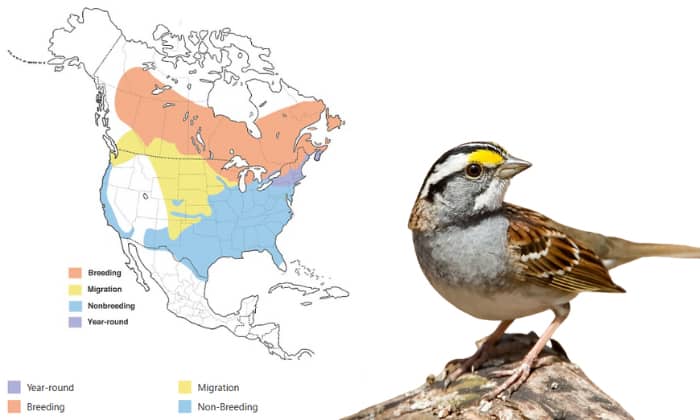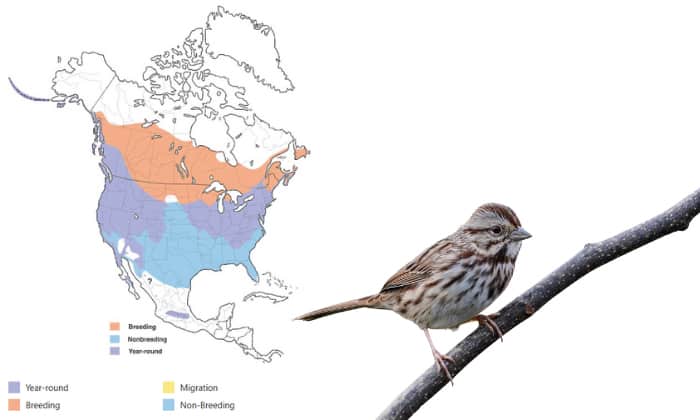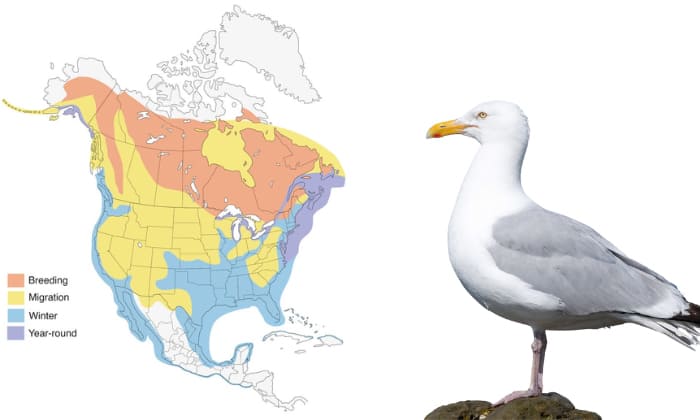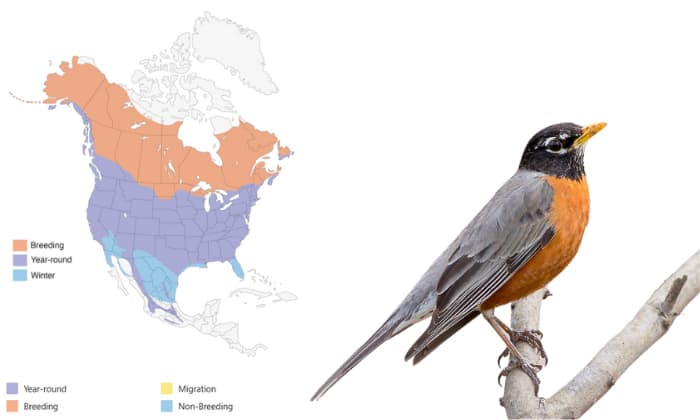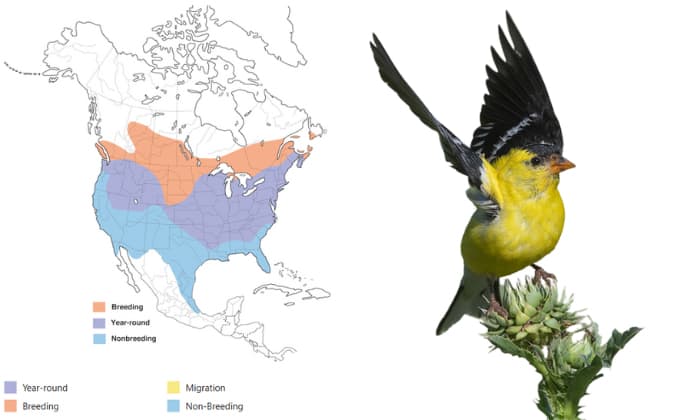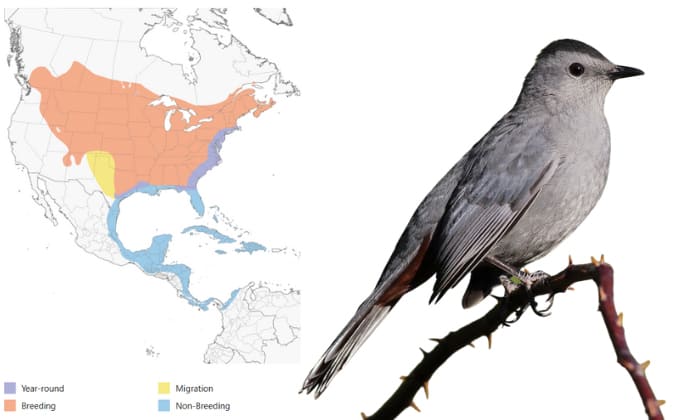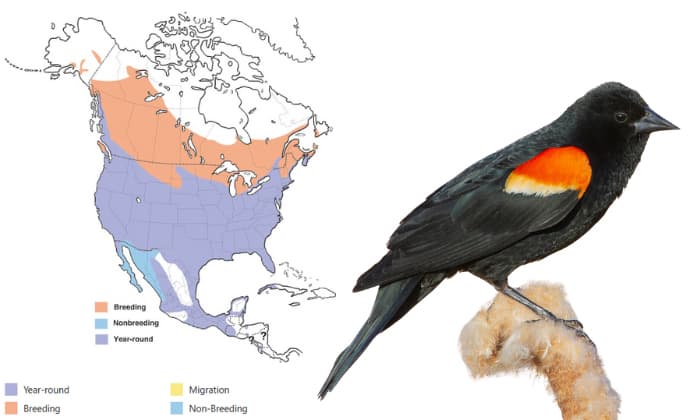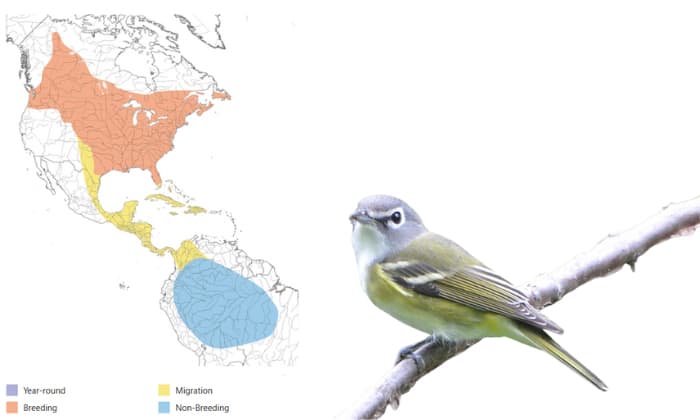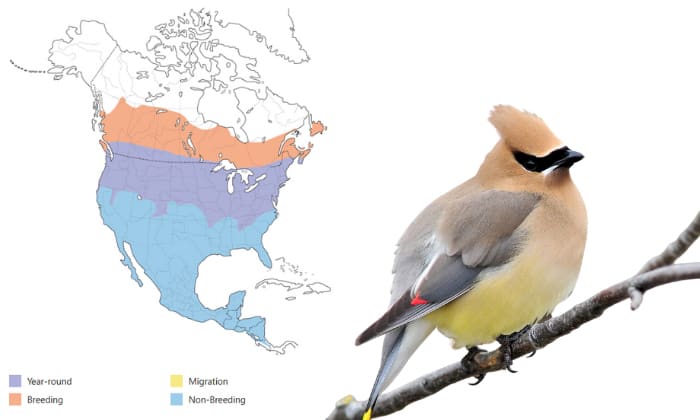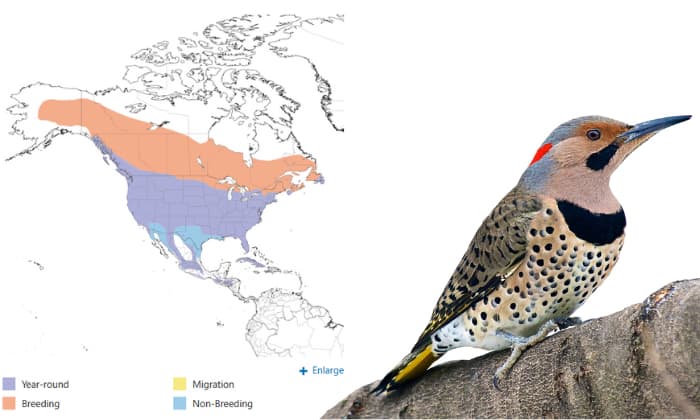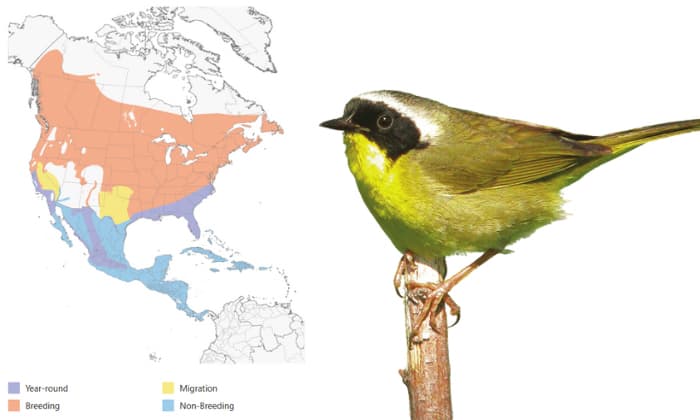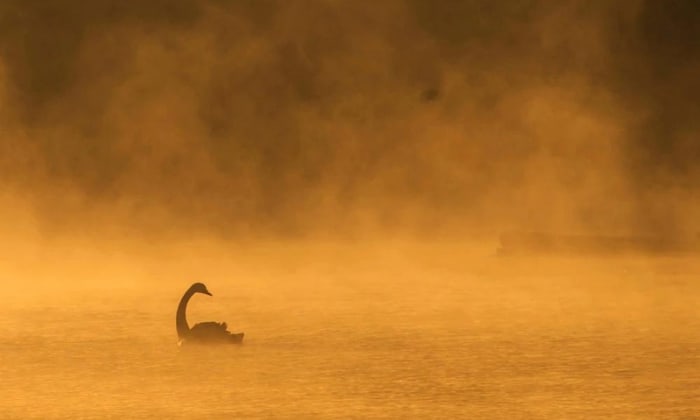Maine is most known for their seafood, but did you know it is also home to hundreds of migratory and native birds?
Some common birds in Maine include the Black-capped Chickadee, Blue Jay, Song Sparrow, Red-winged Blackbird, Gray Catbird, and more.
While some species stick around year-round, some only arrive in the warmer months.
If you want to start birdwatching in the state, here are some bird identification tips for fourteen popular Maine birds!
Table of Contents
- Common Birds Found in Maine (Native and Migratory Birds)
- 1. Black-capped Chickadee (Poecile atricapillus)
- 2. Blue Jay (Cyanocitta cristata)
- 3. Dark-eyed Junco (Junco hyemalis)
- 4. White-throated Sparrow (Zonotrichia albicollis)
- 5. Song Sparrow (Melospiza melodia)
- 6. Herring Gull (Larus argentatus)
- 7. American Robin (Turdus migratorius)
- 8. American Goldfinch (Spinus tristis)
- 9. Gray Catbird (Dumetella carolinensis)
- 10. Red-winged Blackbird (Agelaius phoeniceus)
- 11. Red-eyed Vireo (Vireo olivaceus)
- 12. Cedar Waxwing (Bombycilla cedrorum)
- 13. Northern Flicker (Colaptes auratus)
- 14. Common Yellowthroat (Geothlypis trichas)
- Overview of Birdwatching in Maine
- Common Birds at Different Times in Maine
- Conclusion
Common Birds Found in Maine (Native and Migratory Birds)
There are many more birds in Maine aside from the quintessential Northern Cardinal and Mourning Dove. Here are fourteen species that are a mix of native and migratory birds.
1. Black-capped Chickadee (Poecile atricapillus)
- Average Size: 5 inches
- Average Wingspan: 7 inches
- Life Span: 2-3 years
- Presence in Maine: Year-round
The Black-capped Chickadee is the state bird of three places: the states of Maine and Massachusetts and the provincial bird of New Brunswick, Canada.
Aside from its black cap, the bird has a black bib on its upper chest, streaky wings and tail, and an orangey underside. It is typically about 5 inches long with a wingspan of 7 inches.
These songbirds are known for their thirteen distinct songs that can be heard near forests, wetlands, parks, and cottonwood groves.
Black-capped chickadees are non-picky eaters, eating everything from seeds and berries to insects and meat. They are also bright birds that create multiple caches of food they remember and access up to two months later.
2. Blue Jay (Cyanocitta cristata)
- Average Size: 9-12 inches
- Average Wingspan: 13-17 inches
- Life Span: 7 years
- Presence in Maine: Year-round
Blue Jays are bright blue birds native to eastern North America with intricate feather patterns on their wings and tail. They are usually 9-12 inches long with a wingspan of 13-17 inches.
Though blue jays are technically songbirds, they do not sing. However, they can be noisy and vocal and imitate other birds’ sounds, such as the screech of red-tailed hawks!
Blue Jay imitating a red Tail Hawk
These birds are omnivores that eat insects, eggs, plants, and even nestlings. They live primarily in forests but are very adaptable birds that can be spotted in parks and other residential areas.
They can’t be found on baseball fields, though–that would be the Toronto Blue Jays!
3. Dark-eyed Junco (Junco hyemalis)
- Average Size: 6 inches
- Average Wingspan: 5 inches
- Life Span: 3 years
- Presence in Maine: Year-round
Junco hyemalis are part of the slate-colored group of the dark-eyed junco family. They are small birds about 6 inches long with a wingspan of 8.5 inches and light pink bills.
Dark-eyed juncos can be found in Maine year-round, even through the harsh winters. In the wild, they live in coniferous forests, often seen hopping on the ground foraging for food. However, they occasionally visit bird feeders, picking fallen seeds off the floor.
In other states, these birds are called “snowbirds” because they are primarily winter birds visible at feeders during the cold months.
4. White-throated Sparrow (Zonotrichia albicollis)
- Average Size: 5 inches
- Average Wingspan: 9 inches
- Life Span: 5-6 years
- Presence in Maine: Year-round
White-throated sparrows are one of the easiest sparrow species to identify because of their bright white throat feathers. They also have a distinct yellow spot between their eyes.
These songbirds are typically 6.5 inches long with a wingspan of 9 inches. They have two voice boxes called syrinxes instead of one larynx, which enables them to produce a whistling song.
White-throated Sparrow Sings – 4k
White-throated sparrows live at the edges of forests, ponds, fields, and meadows. They are also frequent visitors at bird feeders, happily munching on seeds and insects.
These birds can be found in Maine year-round but in different areas. They tend to populate the entire state in summer and winter and retreat to coastal regions in the winter.
5. Song Sparrow (Melospiza melodia)
- Average Size: 4-7 inches
- Average Wingspan: 7-10 inches
- Life Span: 2-5 years
- Presence in Maine: Spring and summer; year-round along the coast
As their name suggests, song sparrows are known for their beautiful singing which stays consistent despite regional differences in appearance.
Song Sparrow Singing a Song
These brown birds typically have brown heads and backs marked with dark brown streaks and white bellies. They are 4-7 inches long with a wingspan of 7-10 inches.
Song sparrows prefer living near water, either near the coast or in marshes. However, they are adaptable birds and thrive in residential and agricultural fields.
The diet of each song sparrow depends on its location. While they mainly forage for insects and seeds on the ground, those that live in marshes can also eat small crustaceans such as shrimp.
This species should not be confused with house sparrows which are an invasive species, more aggressive, and have fuller chests, rounder heads, and shorter tails.
6. Herring Gull (Larus argentatus)
- Average Size: 22-26 inches
- Average Wingspan: 54-57 inches
- Life Span: 8-20 years
- Presence in Maine: Year-round
Being along the coastline, Maine is known for its seafood–and sea birds! Herring gulls are large Maine birds found year-round along the coast.
Though notorious for bothering beachgoers by standing around, waiting for food, they can hunt for themselves by catching fish from the ocean and breaking open crustaceans by dropping them on rocks.
These gulls aren’t limited to the coast, though. Herring gulls have adapted to urban areas well and can frequently be spotted anywhere with plenty of food, such as malls and fast-food restaurants.
Their appearance changes drastically every year for the first four years of their life. When fully grown, these gulls have pale gray wings and backs, yellow bills, and characteristic pink legs.
7. American Robin (Turdus migratorius)
- Average Size: 9-11 inches
- Average Wingspan: 12-16 inches
- Life Span: 2 years
- Presence in Maine: Spring and summer in Central and North Maine; Year-round in South Maine
American robins are so prevalent they are the state bird of three different states: Connecticut, Wisconsin, and Michigan.
These medium-sized birds have dark brown heads and uppersides and rusty orange undersides. They are often found (and heard) in woodlands, farmlands, and urban areas.
American robins typically eat insects in the spring and summer, with their favorite grub being earthworms. In the winter, they switch to berries and fruit, which can sometimes lead to intoxication, mainly when they eat fallen, fermented fruit!
These robins are one of five subspecies found in North America. They are found in southern Maine year-round but can be spotted in central and northern Maine during spring and summer.
8. American Goldfinch (Spinus tristis)
- Average Size: 5 inches
- Average Wingspan: 8 inches
- Life Span: 3-6 years
- Presence in Maine: Year-round in most of Maine
It’s easy to tell apart male and female American Goldfinches. Males come in brighter shades of yellow and have black foreheads. Females typically have duller yellow feathers, nearly a shade of tan.
However, American Goldfinches are the only finch species that molt twice a year, so be on the lookout for slight variations in their appearance!
These songbirds love open habitats such as fields, meadows, and plains. They are also known as one of the “strictest vegetarians” among birds, primarily sticking to seeds they can easily crack open with their sharp, conical bills.
American Goldfinches are found year-round throughout most of Maine but may be sparser during the winter months in the northern part of the state.
9. Gray Catbird (Dumetella carolinensis)
- Average Size: 8-9 inches
- Average Wingspan: 9-11 inches
- Life Span: 6 years
- Presence in Maine: Spring and summer
The Gray (or grey) Catbird is also known as the slate-colored mockingbird. They are primarily grey with darker-colored scalps, dark orange under tails, and mostly black tails. They are about the size of a robin, 8-9 inches long, with a 9-11 inch wingspan.
Catbirds pronounce a raspy meow-like call which is what inspired their name. However, they easily mimic the sounds of other birds and animals (such as tree frogs!) like other mockingbird species.
These gray birds like living in areas with dense vegetation. This includes overgrown fields, woods with plenty of brush, and sometimes swamps. They maintain a mixed diet of insects, worms, fruit, and berries.
While these birds spend their breeding season in Maine, they migrate south during the colder season.
10. Red-winged Blackbird (Agelaius phoeniceus)
- Average Size: 7-9 inches
- Average Wingspan: 12-15 inches
- Life Span: 2 years
- Presence in Maine: Spring and summer; along the coast year-round
Despite their difference in appearance, both males and females of this species have red patches on their wings. It is more visible on males against their stark black feathers but brownish females also have a reddish patch on their shoulders.
Males typically flash these red marks to defend their territory or attract mates.
These birds are 7-9 inches long with a wingspan of 12-15 inches. They can be found everywhere in North America except for extreme habitats such as the Arctic, extremely high altitudes, and deserts.
This blackbird is an omnivore, switching between insects and plants.
11. Red-eyed Vireo (Vireo olivaceus)
- Average Size: 5 inches
- Average Wingspan: 9-10 inches
- Life Span: 10 years
- Presence in Maine: Spring and summer
The Red-eyed vireo’s olive-green feathers help it camouflage against the tree canopy it loves to dwell in.
However, what they can’t hide is their singing. These birds sing all day, particularly during the summer.
Red-Eyed Vireo Song
They have been recognized by the Guinness Book of World Records for two prizes: the longest time spent continuously singing and the most repetitions of that song in that period. Specifically, the winning vireo sang for 10 hours straight and repeated his song 22,000 times!
These small Maine birds are only about 5 inches long, about the size of a Yellow Warbler. They live in big, leafy trees, eating insects in the summer and berries in the water.
12. Cedar Waxwing (Bombycilla cedrorum)
- Average Size: 6-7 inches
- Average Wingspan: 9-12 inches
- Life Span: 8 years
- Presence in Maine: Year-round in central and southern Maine; spring and summer in northern Maine
Cedar Waxwings are gorgeous birds with their smooth, silky appearance of browns, grays, and yellows. They are about 6-7 inches long with a wingspan of 9-12 inches, making them bigger than sparrows but smaller than robins.
Their name comes from a red, waxy secretion on the tips of their flight feathers. However, the exact color can change depending on their diet!
These birds travel in flocks and prefer woodlands, farms, orchards, and gardens with lots of fruit and berries. Though they are primarily fruit-eaters, they are also insectivores.
Cedar Waxwings can be spotted year-round in central and southern Maine but only in the spring and summer in the northern part of the state.
13. Northern Flicker (Colaptes auratus)
- Average Size: 11-14 inches
- Average Wingspan: 16-21 inches
- Life Span: 8 years
- Presence in Maine: Spring and summer
Northern Flickers are 11-14 inches long with a wingspan between 16-21 inches. Despite being woodpeckers, Northern Flickers like to forage for insects on the ground instead of on trees. These birds are distinctly known for their love of ants!
This extremely colorful woodpecker has shades of gray, deep rose, tan, and brown. It has a spotted belly, wings marked with tiger stripes, and a black-and-white tail.
Males are distinguishable from females by the black “mustache” on their faces. Females lack this facial marking, having all-light-brown heads.
The bird can be found in various habitats with trees, such as parks, yards, and woodlands throughout Maine during the spring and summer months before migrating south for the winter.
14. Common Yellowthroat (Geothlypis trichas)
- Average Size: 5 inches
- Average Wingspan: 7 inches
- Life Span: 2 years
- Presence in Maine: Spring and summer
The Common Yellowthroat is also known as the yellow bandit or the Maryland Yellowthroat. They have tan backs and wing feathers, and bright yellow throats.
The black face mask is a feature among male Common yellowthroats, who can sing over a thousand songs daily. Females have paler brown faces and bodies overall and do not sing.
These birds are typically less than 5 inches long with a wingspan of 7 inches. They can be seen flying around Maine from May to October in the spring and summer months before migrating south for the winter.
Common Yellowthroats thrive in wet areas such as marshes and reed beds with plenty of shrubs and vegetation. Primarily, they eat insects.
Overview of Birdwatching in Maine
Home to 464 types of birds and millions of individual birds, Maine is an excellent region for birdwatching.
1. Best Spots for Birdwatching in Maine
Where you go depends on what kind of birds you want to see. Here is a general guide to where to see what:
- Central and south Maine – forest- and water-based birds
- Northern Maine – best for spotting migratory birds
- Western Mountains – home to some of the less common birds that prefer higher altitudes
- Southwest Coast – birds that love beaches and marshes
- Midcoast – A busy area with bays and peninsulas and overseas bird visitors
- Southeast Maine – A cooler region with birch and conifer trees that is home to a wide variety of species.
2. Best Time for Birdwatching in Maine
The time of the day is essential to consider if you want to spot specific species.
Songbirds and other insectivores are usually active at dawn – as the saying goes, the early bird gets the worm! Get ready to rise early if you are looking to spot robins, blackbirds, and thrushes.
Larger birds of prey, such as eagles and hawks, can be seen soaring in the late morning to early afternoon. The warmer air at this time of day helps them fly more efficiently.
Last, but not least, come out at night to see nocturnal species. These include owls, nightjars, and night herons.
3. Tips for Successful Bird Watching in Maine
While you can get better at anything with enough practice, try these tips to optimize your bird-watching from the get-go:
- Study in advance – as much as you can, learn how to identify birds by sight and sound so you can quickly react while in the field.
- Wear dark clothing – white and bright-colored clothes can scare birds away. It’s best to wear darker grey, green, and brown clothes.
- Always keep the sun at your back – it’s hard to spot birds when you’re squinting!
- Invest in good binoculars – proper birding binoculars can make your trip more enjoyable.
- Be patient – Sometimes you’ll spot many birds, sometimes none. The important thing is to keep trying and be patient.
Common Birds at Different Times in Maine
There are three ideal birdwatching times in Maine.
In the spring, enthusiasts can spot incoming migrants such as ducks, finches, and hawks.
Summer is the busiest time when over 140 Maine wild birds are breeding around the state. By September, residents can observe migrants such as hawks and sea ducks leaving the state.
Lastly, fall brings unique species from further north in Canada down south to Maine.
Here is a rough estimate of your chances of spotting the species on this list:
| Summer | Winter |
| Song Sparrow 46.8%
American Goldfinch 43.6% American Robin 42.9% Black-capped Chickadee 42.2% Blue Jay 33.5% Common Yellowthroat 32.9% Mourning Dove 31.7% Red-winged Blackbird 28.7% Gray Catbird 27.6% |
Black-capped Chickadee 52.0%
Blue Jay 31.6% American Goldfinch 27.6% Northern Cardinal 22.5% Other possible winter species include the American crow, White-breasted Nuthatch, Tufted Titmouse, and Downy Woodpecker.
|
Conclusion
It’s easy to appreciate the sounds and sights of birds when you are in a state like Maine. There are so many common birds in Maine it’s almost impossible not to see them constantly!
However, knowing a little about each species helps you appreciate them beyond their feathers and songs.
After you spot all fourteen birds on this list, why not try to learn about another fourteen? The more you know, the more you can appreciate the nature around you.

George and I became friends after a birdwatching trip with our new group. And we have been enjoying every adventure together. When he told me the idea of establishing a site that shares our experiences and fun, I immediately agreed. After trials and errors, here we have Thayerbirding.


